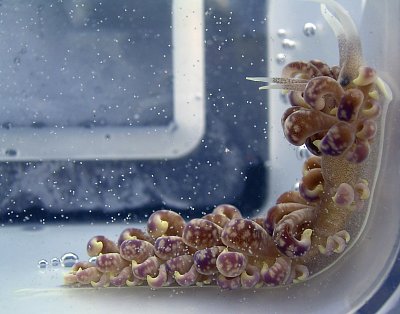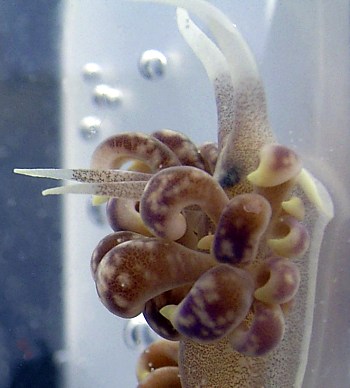Phyllodesmium magnum on Sinularia
January 17, 2003
From: Cameron Bee

Dear Bill,
Could you give me some information on this nudibranch. I propagate corals for the aquarium trade and this slug has caused major damage to a colony of the soft coral Sinularia which we obtained from about 20km of Cairns [North Queensland, Australia].
It "ate" a substantial amount of the parent material that we use for our coral propagating. Typically it left an eaten trail up the side of the Sinularia and up to the branches but mostly on the side. Also where it had been feeding turned into nasty black necrotic tissue and basically caused the coral to start disintegrating. There were actually two of them in the tank always near each other. Apart from black rotting Sinularia, I noticed two egg masses which were white and had typical zig-zag pattern. When these egg masses were removed they began to release larvae which "swam" around like zooplankton and were attracted to the light.
When the adult nudibranch (assuming that these were their eggs) were disturbed, the lobes on its dorsal side detached and were very sticky and had to be pulled off. These sticky bits would then wriggle about like a lizard tail for about 3 hours which was until I left our factory, the following morning they were not moving and neither were the adults as oxygen in water had plummeted during the night.
Cameron
fishboy@smartchat.net.au



Dear Bee,
This is an aeolid nudibranch, Phyllodesmium magnum. Sorry it has caused so much damage, but Sinularia seems to be its preferred food, and your experience certainly supports that idea. The egg mass almost certainly belongs to Phyllodesmium and your description of it 'releasing' suggests that the larvae were about to hatch when you touched the egg mass. It may be worth keeping an eye out for any larval settlement. While the larvae of many nudibranchs spend a considerable time in the plankton feeding on phytoplankton, some species have an abbreviated non-feeding larval period, before settling on the adult food item to begin life as a crawling slugs. Non-feeding larvae can easily survive aquarium life, whereas feeding larvae need special facilities. Your animal could easily be one of the species with non-feeding larvae.
The sticky 'lobes' which you mention fall off and wiggle like lizard's tails, are called ceras, and as you'll see on the species Fact Sheet this is one of their defensive strategies. Dropping body parts like this is called autotomy.
One interesting feature of this species are the microscopic brown specks which can be seen in the close-up of the head alongside, and in the other photos. These brown specks are clusters of microscopic plants, called zooxanthellae, which it gets from the soft-corals it feeds on. It farms these plants, allowing them to photosynthesise in sunlight to provide it with nutrients. Have a look at the solar powered sea slug page for further information.
I am sure I am more sympathetic to Phyllodesmium than you are, but this is a very fascinating animal.
Cheers,
Bill Rudman
Related messages
-
Phyllodesmium from Lembeh, Indonesia
From: Brian Mayes, March 2, 2009 -
Phyllodesmium magnum from Nhatrang, Vietnam
From: Hua Thai Tuyen, June 5, 2008 -
Re: Phyllodesmium magnum on Sinularia
From: Gary Cobb, April 4, 2008 -
Re: Phyllodesmium magnum on Sinularia
From: Gary Cobb, April 4, 2008 -
Phyllodesmium magnum juveniles
From: Gary Cobb, April 3, 2008 -
Re: Phyllodesmium magnum on Sinularia
From: Gary Cobb, April 3, 2008 -
Phyllodesmium magnum on Sinularia soft coral
From: David Mullins, October 17, 2007 -
Phyllodesmium magnum - trailing observation
From: Jean-François Hervé, September 5, 2006 -
Phyllodesmium magnum pair from the Red Sea
From: Binyamin Koretz, October 13, 2005 -
Phyllodesmium magnum from Elat, the Red Sea
From: Matan Ninio, April 13, 2005 -
Re: Phyllodesmium magnum from Thailand
From: Paul Whitehead, January 25, 2004 -
Re: Phyllodesmium magnum from Thailand
From: Paul Whitehead, January 23, 2004 -
Phyllodesmium magnum from the Marshall Islands
From: Scott Johnson, September 11, 2002 -
Unknown reef tank inhabitant
From: Dean Burchell, July 23, 2002 -
Reef Tank Hitchhiker
From: Mike Nolette, May 21, 2002 -
Phyllodesmium magnum - size?
From: Valda Fraser, April 10, 2002 -
Food of orange Phyllodesmium magnum
From: Leslie Chan, September 11, 2001 -
An orange Phyllodesmium magnum from Hong Kong
From: Leslie Chan, September 9, 2001 -
Phyllodesmium magnum from Queensland
From: Nigel Holmes, July 10, 2001 -
Phyllodesmium magnum from South Africa
From: Valda Fraser, May 26, 2001 -
Phyllodesmium magnum from Hong Kong
From: Bernard Picton , March 4, 2001 -
Phyllodesmium magnum from Japan
From: Yasuhiro Shirai, November 23, 1999
